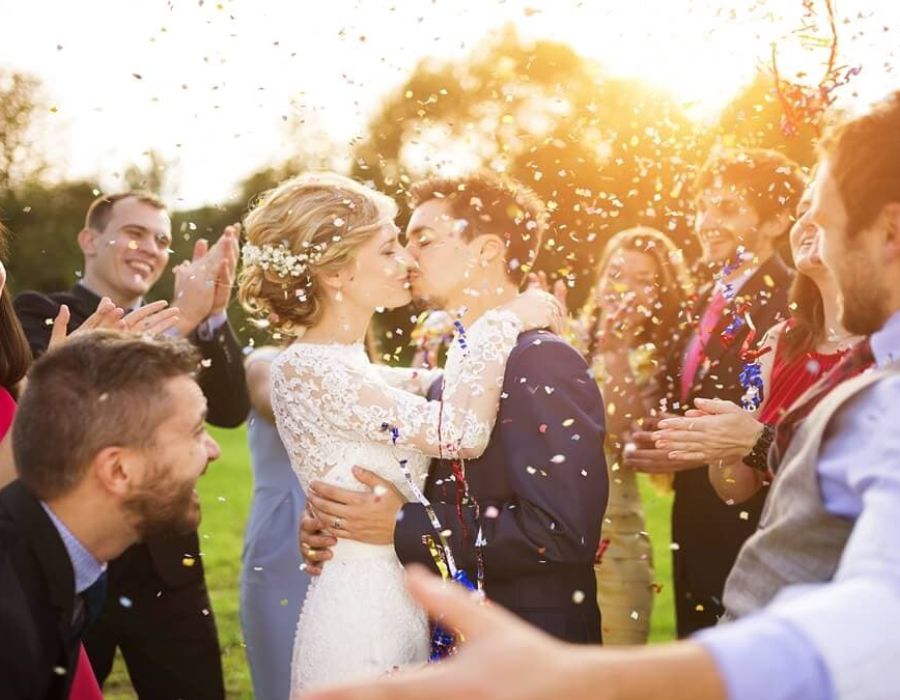Polish wedding traditions are a vibrant tapestry of culture and joy, offering a unique glimpse into the country’s rich heritage. From the engaging “Oczepiny” ceremony to the heartfelt “Bread and Salt” welcome, these customs blend the old with the new in celebration of love and community. Dive into the captivating world of Wedding Traditions in Poland, where each ritual is steeped in meaning and festivity.
Wedding Traditions in Poland – All You Need to Know About the Special Day
Polish weddings are a beautiful amalgamation of traditions, joy, and an undeniable sense of community that marks the celebration of love and union. The essence of these Polish Wedding Traditions spans from pre-wedding customs to the ceremonial magnificence of the wedding day itself. Each step is steeped in rich cultural heritage, making it a truly unique experience.
The Pre-wedding Phase in Wedding Traditions in Poland
The pre-wedding phase in Polish tradition encompasses a series of engaging and heartfelt rituals in Polish Wedding Traditions, from the engagement agreement and blessings to vibrant bridal showers and bachelor parties, laying the foundation for the union of two families and the joyous journey ahead.
- Engagement Agreement and Blessing
This marks the formal acknowledgment of the engagement. The couple seeks blessings from their parents, signifying respect and the merging of two families. It’s a heartfelt moment, often accompanied by a small gathering and intimate celebrations.
- The Bridal Shower (Wieczór Panieński)
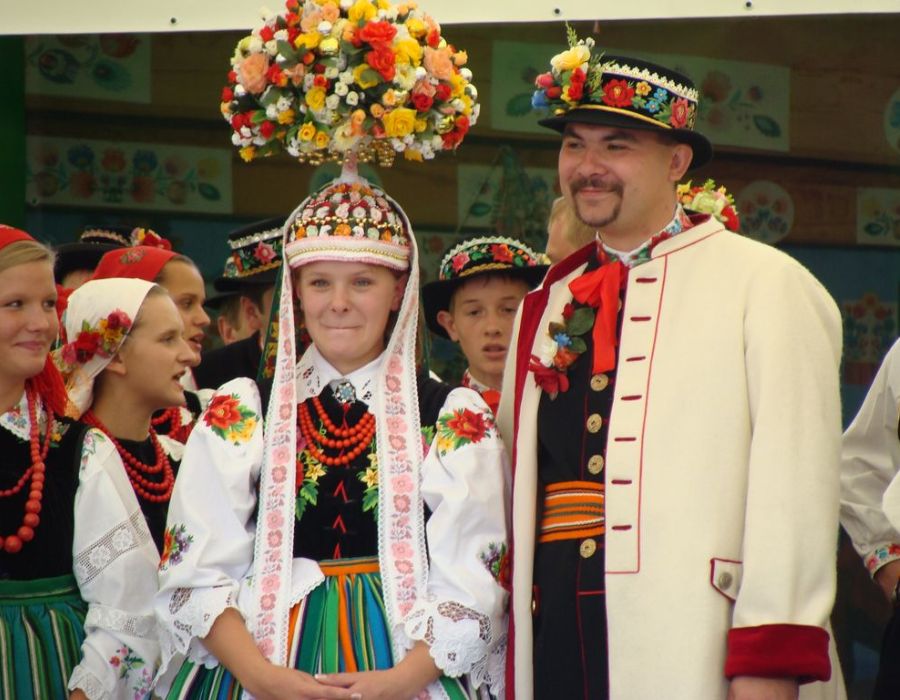
A night of laughter, games, and bonding for the bride and her closest female friends and family members. It’s the Polish twist on a bachelorette party, filled with fun activities and emotional moments that celebrate the bride’s last day as a single woman.
- The Bachelor Party (Wieczór Kawalerski)
Parallel to the bridal shower, in one of the Polish Wedding Traditions, this is the groom’s night out with his male friends. It’s a time for jest, shared stories, and brotherly advice, marking the groom’s last day as a bachelor with festivity and camaraderie.
- The Pre-Wedding Agreement (Zrękowiny)
Zrękowiny is a formal engagement ceremony where both families meet, and wedding plans are discussed and finalized. It’s a blend of tradition and practicality, setting the stage for the upcoming nuptials.
- Parental Blessing
Just before the wedding, the couple receives a blessing from their parents. It’s a poignant moment, filled with emotions, prayers, and wishes for the couple’s future happiness and prosperity
The Wedding Invitations in Wedding Traditions Polish
Polish wedding invitations encapsulate the essence of the country’s rich cultural heritage and the importance of the upcoming nuptials through various unique Polish Wedding Traditions:
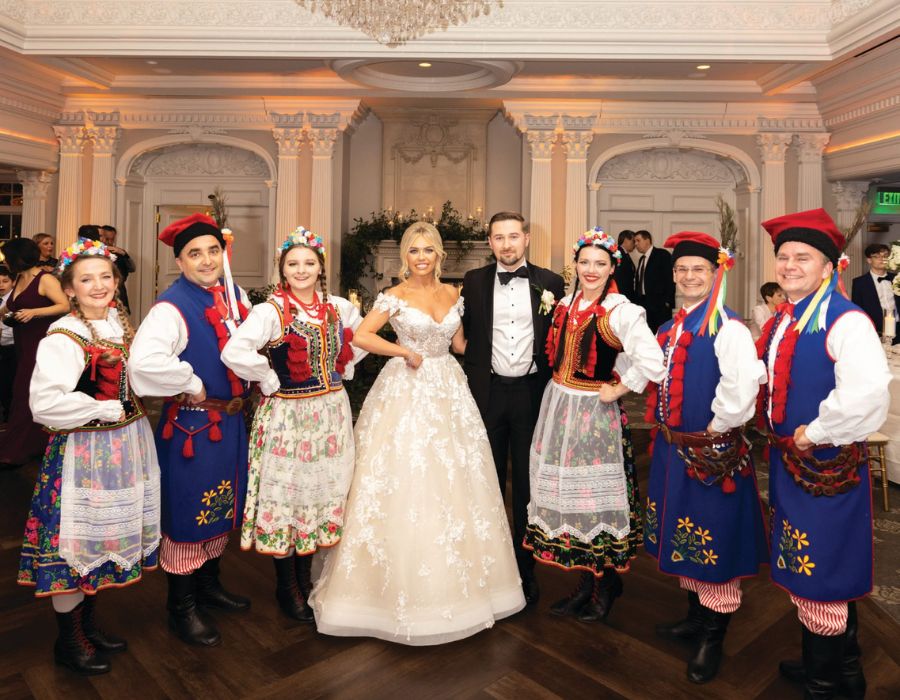
- Hand-Delivery: Traditionally, many Polish couples prefer to hand-deliver their wedding invitations to each guest as a sign of respect and to personally express their desire for the invitee’s presence at their wedding.
- Elegant Design with Cultural Elements: In the Polish Wedding Traditions, the invitations are often elegantly designed, incorporating elements of Polish culture such as folk motifs, the Polish eagle, or traditional floral designs, reflecting the couple’s heritage and the solemnity of the occasion.
- Incorporation of Poetry and Romantic Phrases: It’s common to find beautifully written poetry or romantic phrases in Polish wedding invitations, adding a personal and heartfelt touch that speaks volumes of the couple’s journey and love for each other is also one of the Wedding Traditions Polish.
- Parents as Hosts: In many invitations, the parents of the bride and groom are listed as the hosts of the wedding, a nod to the tradition where parents would traditionally arrange the marriage and invite guests to celebrate the union of their children.
- Formal Invitation Language: The language used in Polish wedding invitations tends to be formal as one of the Wedding Traditions Polish, reflecting the importance and solemnity of the event, with a focus on inviting guests to share in the joy of the couple’s union.
The Wedding Day in Polish Wedding Traditions
Wanting to know What Happens at a Polish Wedding? The Wedding Day in Poland is a majestic fusion of solemn church ceremonies and spirited receptions, marked by age-old traditions, lively music, and a banquet that celebrates the couple’s journey into married life, adorned with exquisite wedding decorations.
- Church Ceremony: A central and solemn part of the Polish wedding, where the couple exchanges vows in a traditional Catholic service, deeply rooted in Poland’s religious heritage.
- Bread and Salt Blessing: Upon entering the wedding reception, the newlyweds are greeted with bread and salt by their parents, a symbol of prosperity and the hardships they will face together.
- First Dance: Unlike the typical Western first dance that happens at the beginning of the reception, the Polish first dance is a highly anticipated event, often involving a traditional polka or waltz, symbolizing the couple’s first steps as a married duo.
- Oczepiny Ceremony: A pivotal moment where the bride transitions from being a single woman to a married one. Her veil is removed, symbolizing her new status, and often replaced with a cap or a touch of the groom’s hat, followed by games that predict who will marry next.
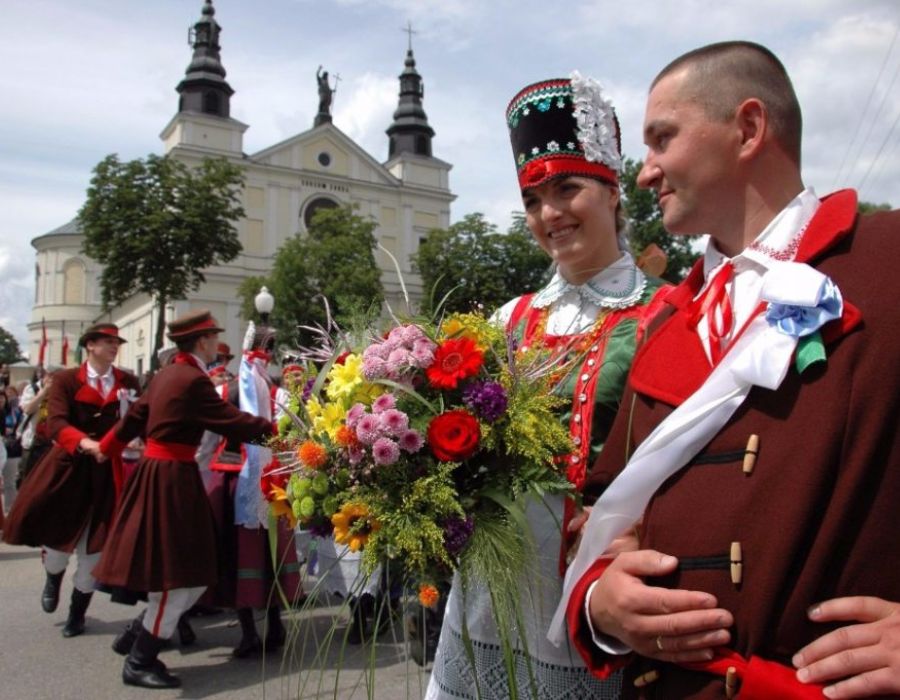
- The Midnight Unveiling (Oczepiny): Marking the transition from formal to informal celebration, this among all the Polish Wedding Traditions includes the symbolic unveiling of the bride, games, and sometimes the auctioning of the bride’s veil, leading into more relaxed and spirited festivities.
- Money Dance: Guests pay for the privilege to dance with the bride, offering cash pinned to her dress or deposited into a purse, a gesture that contributes to the couple’s future prosperity.
- Wedding Soup: A traditional Polish feast begins with a special wedding soup, often a rich broth with noodles or dumplings, symbolizing the couple’s first meal shared as husband and wife.
- Poprawiny: The day after the wedding, a less formal gathering that allows the newlyweds to celebrate once more with their guests, often involving more food, drink, and merriment, reinforcing the community’s support for the couple.
The wedding party in Wedding Traditions Polish
The wedding party in Poland is a jubilant celebration that extends well beyond the formalities, featuring a feast, traditional dances, and games. It’s a testament to Polish hospitality, where guests revel in the happiness of the newlyweds until the early hours of the morning. Knowing What Happens at a Polish Wedding helps you be more in touch with the event.
- Oczepiny Ceremony: This is a pivotal moment in the Polish wedding party as one of the Polish Wedding Traditions, marking the transition of the bride from a single woman to a married one. The bride’s veil is ceremoniously removed, symbolizing her new status, and often replaced with a cap or headscarf.
- The First Dance: Unlike the typical first dance seen at weddings, in Wedding Traditions in Poland, this moment holds a deeper tradition. It’s not just about the bride and groom but opens the dance floor for everyone with specific songs that hold cultural significance.
- Bread and Salt Blessing: Upon entering the reception venue, one of the Polish Wedding Traditions is when the newlyweds are greeted with bread and salt by their parents. This gesture symbolizes wishes for prosperity and the overcoming of life’s hardships together.
- Midnight Unveiling: In some Polish weddings, there’s a tradition where the bride undergoes a ‘second unveiling’ at midnight. This involves a more informal outfit change and signifies the bride’s transition into married life, celebrated with a lively dance.
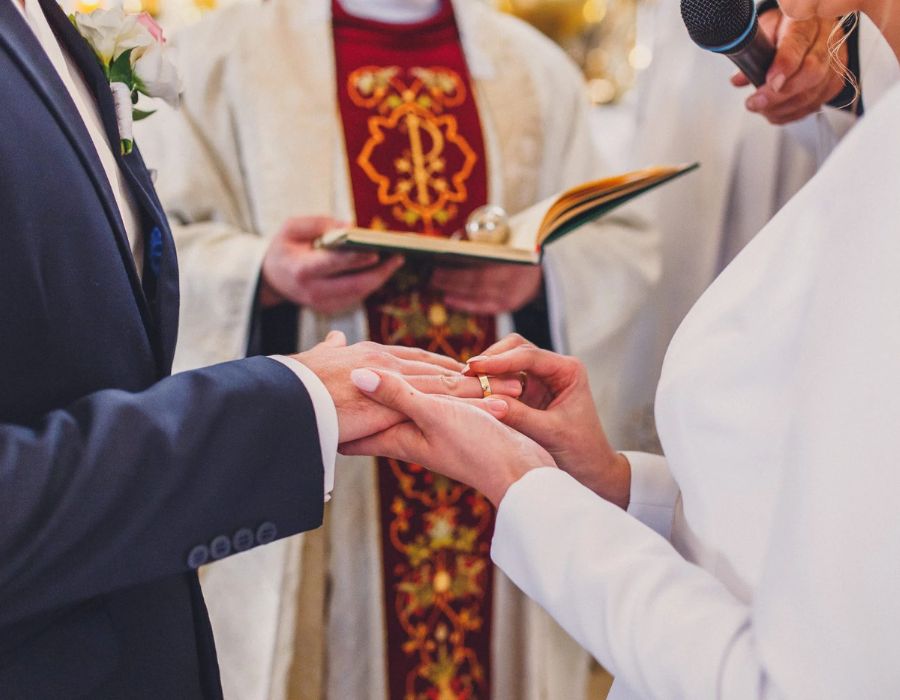
- The Grand Entrance: The newlyweds’ entrance to the wedding party is often dramatic and filled with joy, sometimes involving folk music, traditional dances, or even a march that engages all guests.
- Polish Wedding Games: A variety of games designed to entertain guests and test the newlyweds’ teamwork and dedication. These can range from humorous tasks to heartfelt challenges, ensuring laughter and joy fill the room.
- Customized Gifts for Guests: A unique tradition is the giving of customized gifts to guests, often as a thank you for their participation and blessings. These gifts range from engraved keepsakes, handmade items reflecting Polish culture, to personalized bottles of local spirits or artisanal treats, making each guest feel valued and appreciated.
These Polish Wedding Traditions ensure that the wedding party in Poland is not just a celebration but a memorable event that honors the newlyweds’ past, present, and future, all while keeping the guests actively engaged and cherished through thoughtful gestures like customized gifts.
After wedding day in Wedding Traditions in Poland
The day after the wedding often includes a smaller gathering known as “Poprawiny,” which allows family and close friends to wind down together, reminisce about the festivities, and enjoy leftover delicacies, extending the celebration and togetherness.
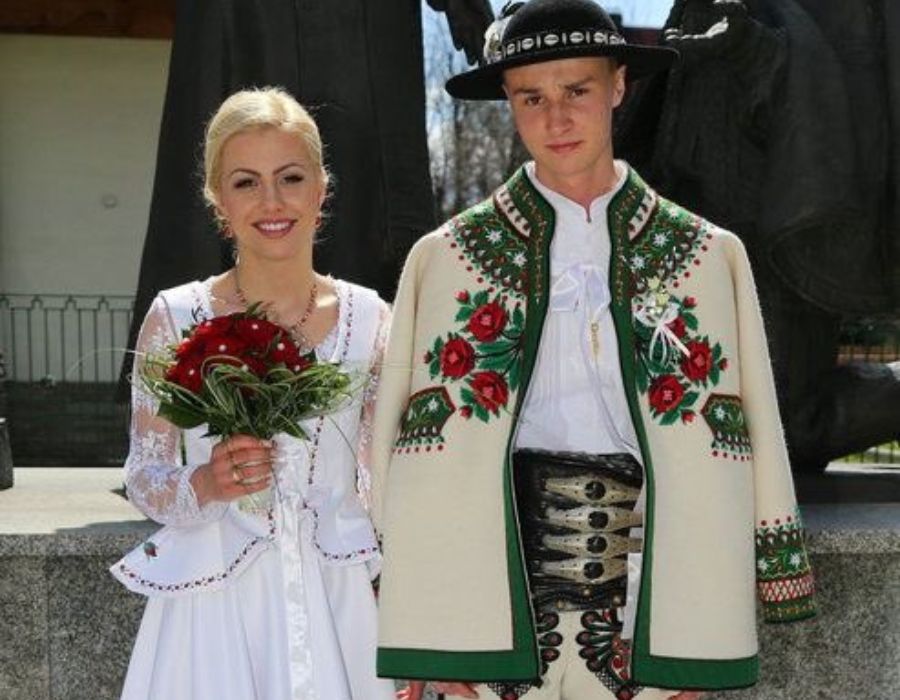
- Poprawiny: One of the unique Polish Wedding Traditions, this is a follow-up celebration held the day after the wedding, allowing guests to continue the festivities in a more relaxed setting, often featuring leftover delicacies from the wedding banquet.
- Sharing of Wedding Cake Leftovers: It’s customary to share a leftover wedding cake with neighbors and friends who couldn’t attend the ceremony, symbolizing the spreading of joy and community spirit.
- Customized Gifts for Guests: A delightful tradition involves presenting guests with customized gifts as a token of appreciation for their participation and blessings. These gifts often include items with a personal touch, reflecting the couple’s gratitude and the shared memories of the celebration.
- Visiting the Church Together: On the Sunday following the wedding, the newlyweds often visit the church together for the first time as a married couple, signifying their commitment to faith and each other in their new journey.
- Family Gathering for Leftovers: The close family members of the newlyweds often gather for a casual meal of wedding leftovers. This intimate gathering allows for reflection on the event and is a time for the families to bond further.
8 Must-Known Polish Wedding Traditions
When orchestrating a Polish wedding, it’s customary to weave in eight fundamental elements that embody the rich histories and traditions of Polish matrimonial celebrations. These elements span from time-honored pre-ceremony rituals to the joyous festivities that unfold in the days following the wedding, each steeped in cultural significance and heritage.
- The Timing
The selection of the wedding month is often influenced by tradition, with many Polish couples preferring months that include the letter ‘R’—believed to bring good fortune in marriage. The favored months are:
- March
- June
- August
- September
- October
- December
These months are thought to bestow luck upon the couple’s union. While challenging, choosing a day with favorable weather is also desirable, with sunshine symbolizing happiness in the marriage, light rain considered a blessing, and thunderstorms seen as an omen to be avoided.
- The Blessing
Prior to the formal ceremony, the bride’s family gathers to offer their blessings to the couple, one of the Polish Wedding Traditions typically facilitated on a Saturday morning. The bride and groom kneel as the bride’s parents sprinkle holy water on them, followed by blessings from other family members.
- The Dress
The pursuit of the ideal wedding attire encompasses a tradition where the bridal gown, adhering to the wedding dress code, is donned merely for a fitting before the day, integrating blue to signify fidelity. The bride further embellishes her ensemble with a blend of old and new elements, borrowing an item from the groom’s family to symbolize prosperity and the seamless blend of past and future.
- The Ceremony
Polish wedding ceremonies, deeply rooted in Catholic tradition, take place in a church and are characterized by their length and the incorporation of numerous rituals. Traditional attire is worn, and the ceremony concludes with the guests showering the couple with rice, barley, or coins for prosperity.
- The Reception
Upon arrival at the reception, the couple is greeted with bread and salt by their parents, symbolizing the hopes of never facing hunger and the strength to overcome life’s challenges. This tradition, significant in many cultures, is sometimes performed publicly at the reception.
- The Dancing
The reception is a lively event filled with dancing to live music into the early hours, where the bride and groom’s first dance is followed by a night of traditional Polish songs and dances, including the Czepek dance, which helps financially support the newlyweds.
- Midnight Ceremony
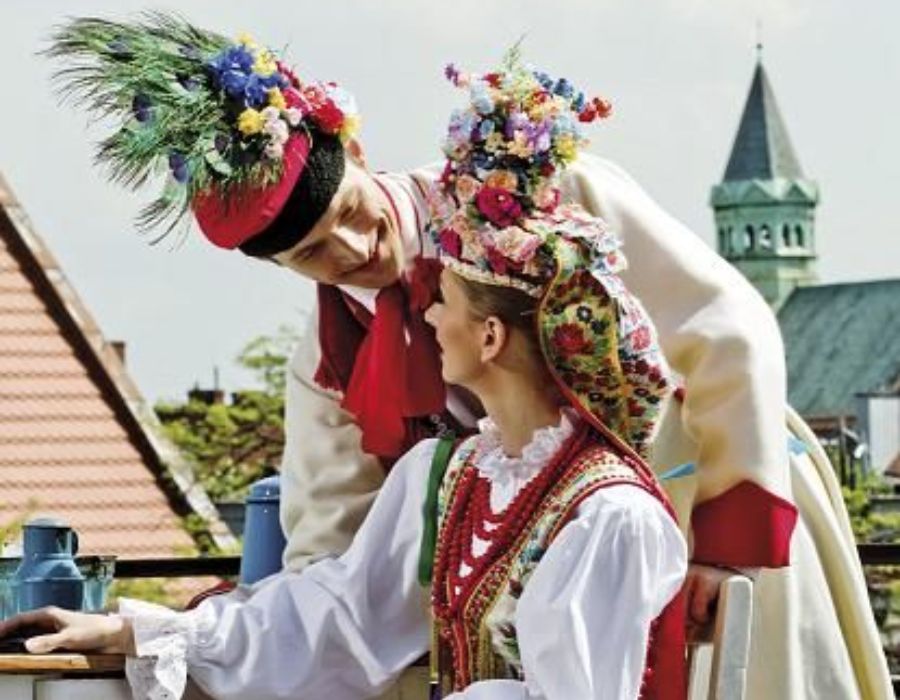
The transition from single to married life is marked at midnight during the Oczepiny ceremony as one of the Polish Wedding Traditions, where the bride transitions from wearing her veil to being gifted a cap, symbolizing her new marital status. This moment also includes the tossing of the veil and the groom’s tie to unmarried guests, predicting who will marry next.
- The Poprawiny
The celebration continues with a second reception, known as Poprawiny, reserved for the closest family and friends. This event extends the festivities into the following day, emphasizing the couple’s role in hosting and ensuring the continued enjoyment and hospitality with more food and drink
Conclusion
Polish wedding traditions are a rich tapestry that weaves together the threads of history, family, and joyous celebration.
From the heartfelt blessings and symbolic Bread and Salt Welcome to the lively Oczepiny ceremony as mentioned and the continuation of festivities into the Poprawiny, each custom is imbued with deep meaning and communal spirit.

